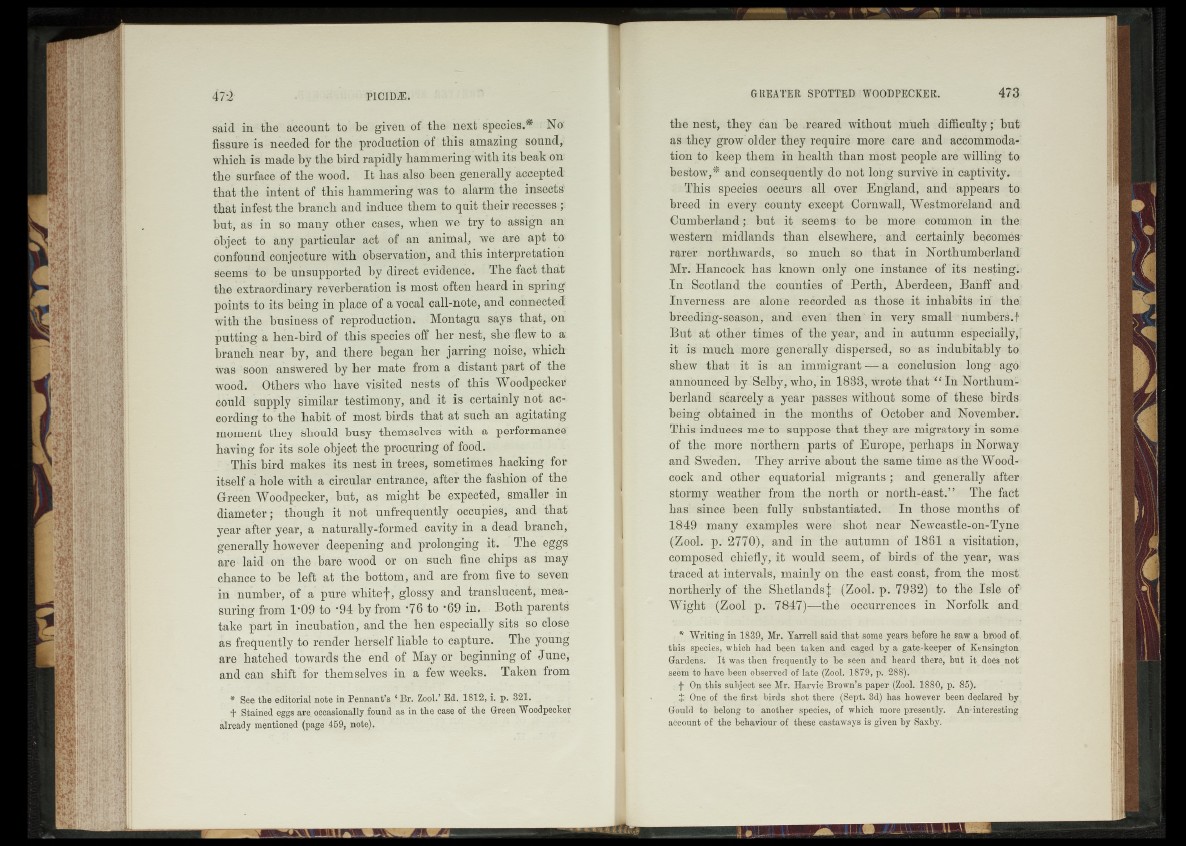
said in the account to be given of the next species.* No'
fissure is needed for the production of this amazing sound,
which is made by the bird rapidly hammering with its beak on:
the surface of the wood. It has also been generally accepted
that the intent of this hammering was to alarm the insects'
that infest the branch and induce them to quit their recesses
hut, as in so many other cases, when we try to assign an
object to any particular act of an animal, we are apt to
confound conjecture with observation, and this interpretation
seems to be unsupported by direct evidence. The fact that-
the extraordinary reverberation is most often heard in spring
points to its being in place of a vocal call-note, and connected
with the business of reproduction. Montagu says that, on
putting a hen-bird of this species off her nest, she flew to a.
branch near by, and there began her jarring noise, which
was soon answered by her mate from a distant part of the
wood. Others who have visited nests of this Woodpecker
could supply similar testimony, and it is certainly not according
to the habit of most birds that at such an agitating
moment they should busy themselves with a performance
having for its sole object the procuring of food.
This bird makes its nest in trees, sometimes hacking for
itself a hole with a circular entrance, after the fashion of the
Green Woodpecker, but, as might be expected, smaller in
diameter; though it not unfrequently occupies, and that
year after year, a naturally-formed cavity in a dead branch,
generally however deepening and prolonging it. The eggs
are laid on the bare wood or on such fine chips as may
chance to be left at the bottom, and are from five to seven
in number, of a pure whitef, glossy and translucent, measuring
from 1-09 to -94 by from *76 to ‘69 in. Both parents
take part in incubation, and the hen especially sits so close
as frequently to render herself liable to capture. The young
are hatched towards the end of May or beginning of June,
and can shift for themselves in a few weeks. Taken from
* See the editorial note in Pennant’s ‘ Br. Zool.’ Ed. 1812, i. p. 321.
+ Stained eggs are. occasionally found as in the case of the Green Woodpecker
already mentioned (page 459, note).
the nest, they can be .reared without much difficulty; but
as they grow older they require more care and accommodation
to keep them in health than most people are willing to.
bestow,* and consequently do not long survive in captivity.
This species occurs all over England, and appears to
breed in every county except Cornwall, Westmoreland and
Cumb erlan d b u t it seems to be more common in the:
'western midlands than elsewhere, and certainly becomes
rarer northwards, so much so that in Northumberland
Mr. Hancock has known only one instance of its nesting.
In Scotland the counties of Perth, Aberdeen, Banff and
Inverness are alone recorded as those it inhabits in the!
breeding-season, and even then in very small numbers.f
But at other times of the year, and in autumn especially,
it is much more generally dispersed, so as indubitably to
shew that it is an immigrant — a conclusion long - ago
announced by Selby, who, in 1838, wrote that “ In Northumberland
scarcely a year passes without some of these birds
being obtained in the months of October and November.
This induces me to suppose that they are migratory in some
of the more northern parts of Europe, perhaps in Norway
and Sweden. They arrive about the same time as the Woodcock
and other equatorial migrants; and generally after
stormy weather from the north or north-east.” The fact
has since been fully substantiated. In those months of
1849 many examples were shot near Newcastle-on-Tyne
(Zool. p. 2770), and in the autumn of 1881 a visitation,
composed chiefly, it would seem, of birds of the year, was
traced at intervals, mainly on the east coast, from the most
northerly of the Shetlandsj; (Zool. p. 7982) to the Isle ofJ
Wight (Zool p. 7847)—the occurrences in Norfolk and.
* Writing in 1839, Mr. Yarrell said that some years before he saw a brood of
this species, which had been taken and caged by a gate-keeper of Kensington
Gardens. It was then frequently to be seen and beard there, but it does not
seem to have been observed of late (Zool. 1879, p. 288).
•J- On this subject see Mr. Harvie Brown’s paper (Zool. 1880, p. 85).
J One of the first birds shot there (Sept. 3d) has however been declared by
Gould to belong to another species, of which more presently. An-interesting
account of the behaviour of these castaways is given by Saxby.